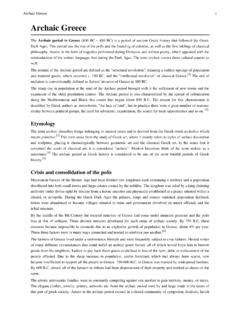Transcription of This text was adapted by The Saylor Foundation …
1 Saylor URL: 1 This text was adapted by The Saylor Foundation under a Creative Commons Attribution-NonCommercial-ShareAlike License without attribution as requested by the work s original creator or licensee. Saylor URL: 2 Principles of Management v. Table of Contents Preface Chapter 1: Introduction to Principles of Management o Chapter Introduction o Case in Point: Doing Good as a Core Business Strategy o Who Are Managers? o Leadership, Entrepreneurship, and Strategy o Planning, Organizing, Leading, and Controlling o Economic, Social, and Environmental Performance o Performance of Individuals and Groups o Your Principles of Management Survivor s Guide Chapter 2: Personality, Attitudes, and Work Behaviors o Chapter Introduction o Case in Point: SAS Institute Invests in Employees o Personality and Values o Perception o Work Attitudes o The Interactionist Perspective: The Role of Fit o Work Behaviors o Developing Your Positive Attitude Skills Chapter 3: History, Globalization, and Values-Based Leadership o Chapter Introduction o Case in Point: Hanna Andersson Corporation Changes for Good o Ancient History.
2 Management Through the 1990s o Contemporary Principles of Management o Global Trends o Globalization and Principles of Management o Developing Your Values-Based Leadership Skills Chapter 4: Developing Mission, Vision, and Values o Chapter Introduction o Case in Point: Xerox Motivates Employees for Success o The Roles of Mission, Vision, and Values o Mission and Vision in the P-O-L-C Framework o Creativity and Passion o Stakeholders o Crafting Mission and Vision Statements o Developing Your Personal Mission and Vision Chapter 5: Strategizing o Chapter Introduction o Case in Point: Flat World Knowledge Transforms Textbook Industry o Strategic Management in the P-O-L-C Framework o How Do Strategies Emerge? o Strategy as Trade-Offs, Discipline, and Focus o Developing Strategy Through Internal Analysis o Developing Strategy Through External Analysis o Formulating Organizational and Personal Strategy With the Strategy Diamond Chapter 6: Goals and Objectives Saylor URL: 3 o Chapter Introduction o Case in Point: nucor Aligns Company Goals With Employee Goals o The Nature of Goals and Objectives o From Management by Objectives to the Balanced Scorecard o Characteristics of Effective Goals and Objectives o Using Goals and Objectives in Employee Performance Evaluation o Integrating Goals and Objectives with Corporate Social Responsibility o Your Personal Balanced Scorecard Chapter 7.
3 Organizational Structure and Change o Chapter Introduction o Case in Point: Toyota Struggles With Organizational Structure o Organizational Structure o Contemporary Forms of Organizational Structures o Organizational Change o Planning and Executing Change Effectively o Building Your Change Management Skills Chapter 8: Organizational Culture o Chapter Introduction o Case in Point: Google Creates Unique Culture o Understanding Organizational Culture o Measuring Organizational Culture o Creating and Maintaining Organizational Culture o Creating Culture Change o Developing Your Personal Skills: Learning to Fit In Chapter 9: Social Networks o Chapter Introduction o Case in Point: Networking Powers Relationships o An Introduction to the Lexicon of Social Networks o How Managers Can Use Social Networks to Create Value o Ethical Considerations With Social Network Analysis o Personal, Operational, and Strategic Networks o Mapping and Your Own Social Network Chapter 10: Leading People and Organizations o Chapter Introduction o Case in Point: Indra Nooyi Draws on Vision and Values to Lead o Who Is a Leader?
4 Trait Approaches to Leadership o What Do Leaders Do? Behavioral Approaches to Leadership o What Is the Role of the Context? Contingency Approaches to Leadership o Contemporary Approaches to Leadership o Developing Your Leadership Skills Chapter 11: Decision Making o Chapter Introduction o Case in Point: Bernard Ebbers Creates Biased Decision Making at WorldCom o Understanding Decision Making o Faulty Decision Making o Decision Making in Groups o Developing Your Personal Decision-Making Skills Chapter 12: Communication in Organizations o Chapter Introduction o Case in Point: Edward Jones Communicates Caring o Understanding Communication o Communication Barriers o Different Types of Communication Saylor URL: 4 o Communication Channels o Developing Your Personal Communication Skills Chapter 13: Managing Groups and Teams o Chapter Introduction o Case in Point.
5 General Electric Allows Teamwork to Take Flight o Group Dynamics o Understanding Team Design Characteristics o Organizing Effective Teams o Barriers to Effective Teams o Developing Your Team Skills Chapter 14: Motivating Employees o Chapter Introduction o Case in Point: Zappos Creates a Motivating Place to Work o Need-Based Theories of Motivation o Process-Based Theories o Developing Your Personal Motivation Skills Chapter 15: The Essentials of Control o Chapter Introduction o Case in Point: Newell Rubbermaid Leverages Cost Controls to Grow o Organizational Control o Types and Levels of Control o Financial Controls o Nonfinancial Controls o Lean Control o Crafting Your Balanced Scorecard Chapter 16: Strategic Human Resource Management o Chapter Introduction o Case in Point: Kronos Uses Science to Find the Ideal Employee o The Changing Role of Strategic Human Resource Management in Principles of Management o The War for Talent o Effective Selection and Placement Strategies o The Roles of Pay Structure and Pay for Performance o Designing a High-Performance Work System o Tying It All Together Using the HR Balanced Scorecard to Gauge and Manage Human Capital, Including Your Own Saylor URL: 5 Preface Welcome to the textbook revolution (you will have to read on to learn more about the revolution that you have joined in using this material for your class).
6 We are happy to have you on Carpenter, Bauer, and Erdogan s Principles of Management team! Given that Principles is likely to be one of the first management courses, if not one of the first business courses, that students take, our objective in developing this material was to provide students and instructors with a solid and comprehensive Foundation on the fundamentals of management. Each of the 16 chapters is comprehensive but succinct, and action-oriented but not busy (as in busy work). Moreover, the book and supplements have been written in a direct and active style that we hope students and instructors find both readily accessible and relevant. Delivering on Our Promise So how are we delivering on these promises? Let s consider the top three ways cited by instructors and students.
7 First, your Principles book is organized around the well-established planning, organizing, leading, and controlling framework (or, simply, P-O-L-C). The first three chapters introduce you to the managerial context, while the remaining 13 chapters are mapped to one of the four P-O-L-C sections. The P-O-L-C structure provides a number of benefits. Each chapter opens with a brief discussion of how the chapter topic fits in P-O-L-C. For instructors, the use of P-O-L-C as an overarching framework helps with the organization of class material, development of the class calendar, and making choices about adding or removing readings and real-life examples. It also provides them with an invaluable reference point at the beginning and conclusion of each class session to share with students where we ve been, and where we re going next.
8 Pedagogically, this is a simple yet powerful tool to aid and promote student learning. For students, the P-O-L-C typology provides them with an enduring framework for processing and organizing just about everything they will learn and experience, during and beyond their classroom-based education, related to the management of organizations. Second, there are three underlying themes carried through all the chapters. These themes are strategic thinking, entrepreneurial thinking, and active management. Strategy, for instance, is explicitly concerned with the determinants of high performance. Importantly, you will find that we treat performance using the notion of the triple bottom line the idea that economic performance allows individuals and organizations to perform positively in social and environmental ways as well.
9 The triple bottom line is financial, social, and environmental performance. The entrepreneurial dimension reflects an underlying and growing trend that shows that students and instructors see themselves as entrepreneurs and active change agents, not just managers. By starting fresh with an entrepreneurial/change management orientation, we provide an exciting perspective on the principles of management. Finally, starting with the opening chapter, we incorporate an active management perspective to show how leaders and leadership are essential to personal and organizational effectiveness and effective organizational change. Moreover, the concluding section of each chapter is focused on the assessment and development of particular management skills. Students and instructors are active as leaders at an increasingly early age and are sometimes painfully aware of the leadership failings they see in public and private organizations.
10 It is the leader and leadership that bring Principles together. Third, your author team is bringing a truly interdisciplinary perspective to your Principles course. The book that is the Foundation for how you learn about, study, and teach Principles is titled Principles of Management: A Behavioral Approach, and behavioral has very important implications for our emphasis on skills and decision making, coupled with the strategic, entrepreneurial, and leadership orientations. Your authors are award-winning teachers who couple a deep knowledge and experience about the book s conceptual underpinnings with a sincere appreciation for experiential teaching approaches. Saylor URL: 6 Chapter 1 Introduction to Principles of Management WHAT S IN IT FOR ME?










